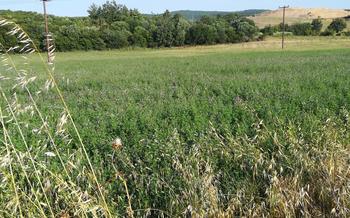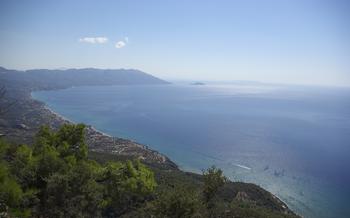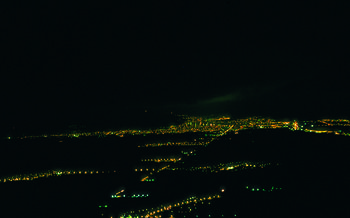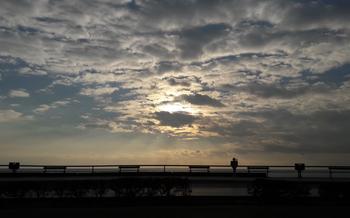
The Wetlands of Kalloni
- The Wetlands of Kalloni: A Natural Paradise
- Exploring the Wetlands
- The Wildlife of Kalloni
- The Kalloni Saltpans
- The Kalloni Lagoon: A Unique and Thriving Ecosystem
- The Kalloni Museum of Natural History
- The Kalloni Wetlands and Sustainable Tourism
- Local Cuisine and Culture
- Accommodation and Dining
- Getting There and Away
- Safety and Precautions
- Things to Pack
- Insider Tip
The Wetlands of Kalloni: A Natural Paradise
Location
The Wetlands of Kalloni are situated on the western coast of the island of Lesvos in Greece, just south of the town of Kalloni. The wetlands form a vast and intricate system of saltpans, lagoons, and freshwater marshes that stretch for over 11,000 hectares, creating a unique and diverse natural habitat.
Size and Composition
The Kalloni Wetlands are one of the largest and most important wetlands in the Mediterranean region. They consist of a complex network of shallow lagoons, saltpans, freshwater marshes, and reed beds, as well as a variety of other habitats such as scrubland, grasslands, and woodlands. The wetlands are fed by several freshwater springs and streams, as well as by seawater from the Aegean Sea.
Ecological Importance
The Kalloni Wetlands are a vital ecosystem that provides a home to a wide range of plant and animal species. The wetlands are particularly important for migratory birds, as they offer a crucial resting and feeding ground for many species on their long journeys between Europe and Africa. The wetlands also support a variety of other wildlife, including reptiles, amphibians, mammals, and fish.
Conservation Status
The Kalloni Wetlands are recognized as a Ramsar site of international importance, and they are also protected under Greek law. However, the wetlands face a number of threats, including habitat loss, pollution, and climate change. Conservation efforts are underway to protect the wetlands and ensure their long-term survival.
Exploring the Wetlands
The best time to visit the Kalloni Wetlands is during the spring and fall migration seasons (April-May and September-October), when hundreds of thousands of birds pass through the area. To fully immerse yourself in the experience, guided tours led by local experts are available, offering insights into the diverse wildlife and ecosystems.
Alternatively, embark on self-guided walks along the well-marked trails that wind through the wetlands, providing ample opportunities for birdwatching and wildlife photography. Popular routes include the Kalloni Saltpans Trail, offering stunning views of the salt flats and the lagoon, and the Kalloni Lagoon Trail, which takes you along the edge of the lagoon, where you can spot waterbirds and other wildlife.
The Wildlife of Kalloni
The Kalloni Wetlands are a haven for wildlife, particularly birds. Over 300 species have been recorded in the area, making it one of the most important birdwatching sites in Greece. The wetlands are a vital stopover point for migratory birds, providing them with food and shelter during their long journeys. Some of the most commonly sighted bird species include flamingos, pelicans, herons, egrets, and various species of ducks and geese.
In addition to birds, the wetlands are home to a variety of other wildlife, including mammals, reptiles, and amphibians. Mammals such as otters, jackals, and wild boar can be spotted in the area, while reptiles and amphibians include turtles, frogs, and snakes. The wetlands are also home to a variety of insects, including dragonflies, butterflies, and mosquitoes.
The wildlife populations in the Kalloni Wetlands vary seasonally. During the winter months, the wetlands are home to a large number of migratory birds, while in the summer months, the resident bird population is more prominent. The wetlands are also home to a number of endangered species, including the Dalmatian pelican and the loggerhead sea turtle. Conservation efforts are underway to protect these species and their habitats.
The Kalloni Saltpans
The Kalloni Saltpans, located within the Kalloni Wetlands, hold significant historical and cultural importance. Their origins can be traced back to ancient times, when salt production played a vital role in the economy and preservation of food. The saltpans were once a thriving industry, providing livelihoods for many local families.
Over the years, the saltpans have undergone various transformations, adapting to changing technologies and market demands. Today, they remain in operation, although on a smaller scale, primarily serving as a source of natural sea salt for local consumption and culinary enthusiasts.
The salt production process at Kalloni is a fascinating sight. Seawater is channeled into shallow evaporation ponds, where the sun and wind work their magic, gradually concentrating the salt content. As the water evaporates, salt crystals form and are harvested by hand using traditional methods.
The Kalloni Saltpans represent a unique blend of tradition and innovation. They not only provide a valuable product but also contribute to the preservation of local heritage and cultural practices. Efforts are underway to promote sustainable salt production methods, ensuring the long-term viability of this centuries-old industry.
The Kalloni Lagoon: A Unique and Thriving Ecosystem
The Kalloni Lagoon is a unique and thriving ecosystem within the larger wetlands complex. It is a shallow, brackish lagoon that is separated from the sea by a narrow strip of land. The lagoon is home to a diverse array of plant and animal life, including many species of birds, fish, and invertebrates.
The Kalloni Lagoon is an important stopover point for migratory birds, and it is home to several breeding pairs of endangered species. The lagoon is also a valuable nursery ground for fish, and it supports a thriving fishing industry.
One of the most unique features of the Kalloni Lagoon is its salinity. The lagoon is much saltier than the surrounding sea, which creates a unique habitat for plants and animals. The high salinity levels also help to preserve the lagoon's water quality and make it a popular spot for swimming and other water sports.
In addition to its ecological importance, the Kalloni Lagoon is also a popular tourist destination. Visitors can enjoy birdwatching, fishing, swimming, sailing, and windsurfing in the lagoon. There are also several hiking trails and bike paths that wind through the lagoon's surrounding wetlands.
The Kalloni Lagoon is a valuable and unique ecosystem that is home to a diverse array of plant and animal life. It is also a popular tourist destination that offers a variety of recreational opportunities.
The Kalloni Museum of Natural History
The Kalloni Museum of Natural History is a treasure trove of knowledge and fascination dedicated to the unique ecosystems and diverse wildlife of the Kalloni Wetlands. Immerse yourself in interactive displays and engaging exhibits that bring the wetlands' natural wonders to life. Learn about the intricate relationships between species and their habitats through captivating presentations and informative panels.
Discover the rich history and cultural significance of the wetlands, gaining insights into the deep connection between the local communities and their natural surroundings. Participate in educational programs and workshops designed to foster a deeper appreciation for the delicate balance of the ecosystem. Take advantage of the museum's research facilities to delve into the scientific wonders of the wetlands and contribute to ongoing conservation efforts.
The Kalloni Wetlands and Sustainable Tourism
Sustainable tourism practices are essential for preserving the delicate balance of the Kalloni Wetlands. Visitors are encouraged to explore responsibly, respecting the wildlife and their habitat. This includes staying on designated trails, avoiding disturbing the birds, and refraining from littering or polluting the environment.
The economic benefits of sustainable tourism can be significant for local communities. By supporting local businesses that prioritize sustainability, such as eco-friendly hotels and restaurants, visitors can contribute to the local economy while minimizing their environmental impact. In addition, sustainable tourism creates employment opportunities for local people, empowering them to become stewards of their environment.
Community involvement in tourism is crucial for its success and sustainability. By working together with local communities, tourism stakeholders can ensure that tourism benefits everyone and that the wetlands are protected for future generations. This can include training local people to become tour guides or nature interpreters, supporting local crafts and businesses, and involving the community in decision-making processes related to tourism.
Balancing tourism and conservation is a challenge that requires careful planning and management. By adopting sustainable tourism practices, promoting responsible behavior among visitors, and supporting local communities, it is possible to ensure that tourism contributes to the conservation of the Kalloni Wetlands while providing economic benefits to the local people.
Local Cuisine and Culture
The local cuisine of Kalloni is a delightful blend of traditional Greek flavors and fresh seafood. Indulge in mouthwatering dishes prepared with locally sourced ingredients, such as freshly caught fish, succulent lamb, and seasonal vegetables. Don't miss out on the famous Kalloni sardines, grilled to perfection and served with a drizzle of olive oil and lemon juice.
Beyond the culinary delights, immerse yourself in the rich cultural heritage of Kalloni. Participate in traditional festivals and events that showcase the vibrant spirit of the local community. Join the locals in celebrating the annual Kalloni Salt Festival, where you can witness traditional salt-making techniques and savor delicious seafood delicacies.
Engage with the warm and welcoming locals, who are eager to share their stories and traditions. Visit the local markets to barter for fresh produce, handmade crafts, and unique souvenirs. Discover the local customs and etiquette, such as the importance of family, hospitality, and respect for the environment.
By embracing the local cuisine and culture, you'll gain a deeper appreciation for the unique charm and authenticity of Kalloni. Your interactions with the locals will leave you with lasting memories and a newfound understanding of this special corner of Greece.
Accommodation and Dining
Accommodation
Kalloni offers a range of accommodation options to suit different budgets and preferences. From traditional guesthouses and family-run hotels to modern resorts and luxury villas, there's something for everyone. For a truly immersive experience, consider staying in a traditional Greek village house, where you can enjoy the hospitality of the locals and immerse yourself in the local culture.
Dining
Kalloni's culinary scene is as diverse as its landscape. From fresh seafood and traditional Greek dishes to international cuisine, there's something to satisfy every palate. Be sure to try local specialties like "saganaki" (fried cheese), "gemista" (stuffed vegetables), and "loukoumades" (Greek doughnuts). For a unique experience, dine at a family-run taverna, where you can enjoy delicious home-cooked meals and soak up the authentic Greek atmosphere.
For Special Dietary Needs
If you have special dietary needs or preferences, Kalloni has you covered. Many restaurants offer vegetarian, vegan, and gluten-free options. Be sure to inform the restaurant staff about your dietary restrictions when making reservations.
Tips for Finding the Best Food and Accommodation
- Ask for recommendations from locals or your hotel concierge.
- Read online reviews and ratings before choosing a restaurant or hotel.
- Take advantage of the many family-run tavernas and guesthouses for a truly authentic experience.
- Don't be afraid to venture off the beaten path and explore the smaller, less touristy villages for hidden culinary gems.
Getting There and Away
Transportation Options to and from Kalloni
Reaching Kalloni is relatively straightforward, with multiple transportation options available. The town is well-connected by road, making it accessible by car or bus. Several bus companies offer regular services from major cities like Athens and Thessaloniki, providing a convenient and affordable way to travel. Additionally, the Kalloni International Airport (MJT) offers seasonal flights to and from various destinations, making it a convenient option for international visitors.
Car Rental and Public Transportation
If you prefer the flexibility of exploring the island at your own pace, consider renting a car. Numerous car rental agencies operate in Kalloni, offering a range of vehicles to suit your needs and budget. Once you have your wheels, you can embark on a scenic drive along the winding roads, discovering hidden beaches and charming villages. Public transportation is also a viable option, with local buses connecting Kalloni to the surrounding towns and villages. While not as frequent as car rentals, buses provide a budget-friendly alternative for getting around.
Ferry Schedules and Connections
For those arriving by sea, Kalloni is connected to the neighboring islands by ferry. Several ferry companies offer regular services to and from islands like Lesvos and Chios, providing a scenic and affordable mode of transport. Check ferry schedules in advance to ensure smooth connections and avoid any delays.
Tips for Planning Your Journey
To make the most of your trip to Kalloni, plan your journey carefully. Consider the time of year you are traveling, as certain seasons offer different experiences. Spring and autumn are ideal for birdwatching, while summer is perfect for swimming and sunbathing. Book your flights or ferry tickets in advance, especially during peak season, to secure the best deals and avoid last-minute surprises.
Safety and Precautions
When exploring the Kalloni Wetlands, safety should be a top priority. Here are some essential tips to ensure a safe and enjoyable experience:
- General Safety:
- Always be aware of your surroundings and avoid walking alone in isolated areas.
- Stay on designated trails and avoid venturing into restricted areas.
-
Beware of uneven terrain, slippery surfaces, and potential hazards like wildlife, insects, and snakes.
-
Health and Medical Considerations:
- Carry a first-aid kit and any necessary medications.
- Be mindful of the sun's intensity and apply sunscreen regularly.
- Drink plenty of water to stay hydrated, especially during hot weather.
-
If you have allergies or specific health concerns, consult a medical professional before your trip.
-
Weather Conditions and Natural Hazards:
- Check the weather forecast before your visit and be prepared for sudden changes in weather conditions.
- Be aware of the risk of wildfires, especially during dry seasons.
-
In case of heavy rain or flooding, avoid low-lying areas and seek higher ground.
-
Respecting Local Culture and Customs:
- Dress respectfully and avoid wearing revealing clothing.
- Be mindful of local customs and traditions, and refrain from any behavior that may be considered offensive or disrespectful.
- Ask for permission before taking photos of people or sensitive areas.
Things to Pack
When embarking on your journey to the Kalloni Wetlands, it's crucial to pack essential items that will enhance your experience and ensure your safety. Here's a comprehensive list of things to consider bringing:
-
Comfortable clothing and footwear: Opt for lightweight, breathable fabrics that are suitable for both warm and cool weather. Sturdy hiking shoes or boots are essential for navigating uneven terrain and protecting your feet from sharp objects.
-
Camera and photography gear: Capture the stunning landscapes, wildlife, and cultural moments with a reliable camera. Consider bringing extra batteries, memory cards, and a tripod for stable shots.
-
Binoculars and wildlife observation equipment: Enhance your wildlife-watching experience with a good pair of binoculars. A spotting scope can also be useful for observing distant birds and animals.
-
Sun protection: The Mediterranean sun can be intense, so pack a hat, sunglasses, and sunscreen with a high SPF to protect your skin.
-
Insect repellent: Mosquitoes and other insects can be a nuisance, especially in the summer months. Bring insect repellent to keep them at bay.
-
First-aid kit: Be prepared for minor injuries or medical emergencies by carrying a well-stocked first-aid kit.
-
Reusable water bottle: Stay hydrated throughout your explorations by bringing a reusable water bottle and refilling it at designated stations in the wetlands.
-
Snacks and energy bars: Pack energy-boosting snacks to keep your energy levels up during long walks or hikes.
-
Local currency and credit cards: While many places accept credit cards, it's always a good idea to have some local currency on hand for small purchases or in case of emergencies.
Insider Tip
Beyond the well-frequented trails, the Kalloni Wetlands offer a world of hidden gems waiting to be discovered. Explore the secluded corners of the lagoon to encounter rare bird species and witness breathtaking sunsets. For the ultimate experience, seek out local guides who can lead you to the best viewpoints and share their knowledge of the wetlands' secrets.
If you're passionate about photography, come prepared with a good camera and telephoto lens to capture the stunning wildlife and landscapes. The wetlands are a haven for bird photographers, with opportunities to photograph a diverse range of species in their natural habitat.
To truly immerse yourself in the local culture, make an effort to interact with the friendly people of Kalloni. Visit the local tavernas, sample the delicious cuisine, and engage in conversations with the locals to learn about their way of life and the rich history of the region.
Finally, consider supporting sustainable tourism initiatives that are working to protect and preserve the Kalloni Wetlands. By choosing responsible tour operators and accommodations, you can contribute to the conservation of this unique natural paradise and ensure its enjoyment for generations to come.




